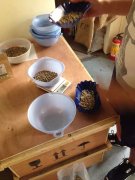Coffee bean specifications and grading skills Coffee basic knowledge

Small and round dark brown coffee beans, in the grinder quietly exudes a fragrant fragrance, into the cup to present the beautiful color of amber, this is the average person for coffee very deep impression of three.
As you explore the history of coffee and its beauty, you can also see the coffee trees that are being caressed by the tropical sun and their green leaves sparkle. It has a small white flower similar to jasmine, its fruit from green to yellow green, and finally turned red, coffee beans are the seeds of its fruit.
Also, if you visit a coffee bean refiner, you will surely see the red flesh called coffee cherries and the fresh green beans with the endocarp and silver skin removed. These are the coffee beans for export.
Coffee is grown in about 60 countries, mostly in areas with elevations of 300 to 400 meters, and sometimes in highlands with elevations of 2,000 to 2,500 meters, but it is said that the quality is better when planted on hillsides above 1500 meters.
The most suitable conditions for cultivating coffee trees are: the average annual rainfall is 1500~2000 mm, and the average temperature is about 20 degrees, and there will be no frost.
Coffee is an evergreen tree belonging to the Accanaceae family. If it grows wild, it can grow to more than eight meters. However, in the farm, the height is cut to about two meters to maintain the quality of coffee beans and facilitate management.
At present, the most important tree species planted are Arabica species, Robusta species (Kanefra species) and Liberica species. It can be subdivided into dozens of varieties, in production, circulation and trading, will also be distinguished.
Even in the same producing country, the climate, altitude and soil quality of each region have subtle effects on the flavor and quality of coffee beans, as well as their own characteristics. Therefore, depending on the variety, origin, brand of different, will have their own different attributes; so can not be a country's coffee beans characteristics, only to describe in one sentence!
Coffee Bean Specifications and Grades
A. Washable/non-washable
Washing type: In the sink, after rubbing with water and utensils, remove pulp and colloid and dry, called washing type coffee beans, its quality is uniform.
Non-washing type: natural drying in sunlight, to remove the pulp and pericarp husker, its quality is unstable.
B. Flat beans/round beans
Coffee fruit is composed of two oval seeds facing each other. One side of the joint is a flat joint, called a flat bean. But there is also a round seed, called round beans, which taste no different. Ripe and red coffee cherries have multiple structures. In the middle is the precursor of coffee beans, light green seeds.
Generally speaking, coffee fruit is composed of two oval seeds opposite each other. The other side of the joint is a flat joint, so it is called flat beans. But there are also ones that consist of a round seed and taste no different.
C. Size of coffee beans
Filter number (mesh no.) Coffee Bean Size
pingdou
20~19 extra large
18 major
17 is large.
16 Ordinary
15 in
14 small
13~12 very small
round bean
13 to 12 large
11 is large.
10 Ordinary
9-of
8 small
D. Elevation
According to the elevation of the cultivated land, it can be divided into three, four and seven grades. Generally speaking, upland beans are of better quality than lowland beans, and because of increased freight costs, prices are higher.
level name Altitude (m)
1 special bean 1.500~
2 superior bean 1.200~1.500~
3 medium bean 1.000~1.200
4 special washed bean 900~1.000
5 Fine washed beans 760~900
6 Premium washed beans 610~760
7 superior washed bean ~610
E. Quality
According to statistical methods, the type and quantity of impurities contained in a certain amount of samples are converted into a percentage of "defect number" to determine the basis of quality class. The smaller the number of defects, the higher the quality.
F. Taste
Brazil, Haiti, Kenya, Sayi and other countries have their own taste test methods, after taste testing before export.
Arabiaca and Robusta species
Arabica and Robusta species account for about two-thirds of the world's coffee production. Not suitable for growing in high temperature, low temperature, rainy, less rainy areas, beans were oval shoulder flat type, characterized by strong fragrance and better quality.
Robusta is bitter and not sour, and the aroma is not very good, so it is suitable for making mixed coffee. Robusta seeds mixed with Arabica seeds are often used to brew iced coffee, instant coffee, and canned coffee. It is characterized by growing in lowlands and strong disease resistance.
The quality and yield of Liberica species are poor, and most of them are exported to Europe, but not imported to Japan.
New crop (new bean) luster is light green, with a unique sour and coffee aroma, very distinctive. (right)
Past crop (a year bean) its color slightly yellow with light green, more recent bean acid and mild. (middle)
Old crop (perennial bean) loses water and is yellow, slightly sour and plain in taste. Usually used as a blend and brewed into canned coffee. (left)
From harvest to shipment
After harvest, the fruit must be removed from the outer skin, pulp, endocarp and silver skin before being shipped to the market. There are two methods: drying (also known as natural method or non-washing) and washing. The dry method is simpler.
First of all, just picked fruit will be widely spread in the sun field for a week or two, until the fruit issued a cracking sound so far, natural drying. After that, the husker removes the dried pulp, endocarp and silver skin. Coffee beans refined in this way are slightly sour and bitter. Almost all coffee beans grown in Brazil, Ethiopia, Yemen and other places are obtained in this way. The disadvantage of this method is that it is easily affected by weather and easily mixed with defective beans and other impurities. Therefore, it must be carefully screened.
Another method is washing, that is, the harvested fruit is placed in a flowing tank, after removing the floating fruit, the skin and pulp are removed by a pulp remover. Then put it in the sink and remove the floating pulp. After that, move into the fermentation tank, soak for half a day to a day, and then dissolve the colloid on the surface of the fermented coffee beans. After washing with water, drying for several days, drying with a machine, and finally removing the endocarp with a huller, it becomes a raw coffee bean that can be used as a commodity.
Washable coffee beans have a better color and less impurities. Colombia, Mexico, Guatemala and other countries about 70% of the production of this method. Sometimes in the fermentation process, if not handled properly, it may emit fermentation odor and its characteristic sour taste; but if handled properly, all kinds of beans can emit their unique coffee aroma. In order to be able to reach the destination intact, raw coffee beans are packed into sacks and placed in special containers for long-distance merchant trips.
Important Notice :
前街咖啡 FrontStreet Coffee has moved to new addredd:
FrontStreet Coffee Address: 315,Donghua East Road,GuangZhou
Tel:020 38364473
- Prev

The pros and cons of coffee have a lot to do with the origin.
The pedigree theory of coffee is the same as red wine, the quality of coffee has a lot to do with the origin. The most famous coffee producers are as follows: Brazil's largest coffee producer. One of the most famous is Sandos Coffee, which tastes mellow, neutral, can be directly boiled, or mixed with other kinds of coffee beans into a comprehensive coffee, is also a good choice. Other kinds of Brazilian coffee such as Rio,
- Next

Coffee name and brand countries according to their own standards are as follows
National place name: indicates the area where coffee is produced. For example, Ethiopia. Harald shows that the product is produced in Harald, Ethiopia. It should be noted here that the name of the country is the same, but when the region and year are different, the quality of coffee is different, and the taste of coffee is not guaranteed to be consistent. Port of export: indicates the port of export of coffee. Coffee of the same origin and brand in the same place.
Related
- Detailed explanation of Jadeite planting Land in Panamanian Jadeite Manor introduction to the grading system of Jadeite competitive bidding, Red bid, Green bid and Rose Summer
- Story of Coffee planting in Brenka region of Costa Rica Stonehenge Manor anaerobic heavy honey treatment of flavor mouth
- What's on the barrel of Blue Mountain Coffee beans?
- Can American coffee also pull flowers? How to use hot American style to pull out a good-looking pattern?
- Can you make a cold extract with coffee beans? What is the right proportion for cold-extracted coffee formula?
- Indonesian PWN Gold Mandrine Coffee Origin Features Flavor How to Chong? Mandolin coffee is American.
- A brief introduction to the flavor characteristics of Brazilian yellow bourbon coffee beans
- What is the effect of different water quality on the flavor of cold-extracted coffee? What kind of water is best for brewing coffee?
- Why do you think of Rose Summer whenever you mention Panamanian coffee?
- Introduction to the characteristics of authentic blue mountain coffee bean producing areas? What is the CIB Coffee Authority in Jamaica?

